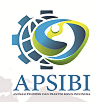Developing Interactive Android-Based E-Learning Media as a Virtual Laboratory for the Students of Office Administration Education
Abstract
The industrial revolution 4.0 leads to an increase in job competition. It should eventually be prepared with personal competence, especially for students in the Department of Office Administration Education. The study aims to develop an interactive e-learning media as a virtual laboratory on a meeting organization course. This study aimed to examine the eligibility of the media and to know the response of the students. This study applied a research and development (R & D) model which developed by Borg and Gall. This virtual laboratory is designed with some attractive features such as (1) meeting schedule, (2) start the meeting, (3) meeting minutes, (4) content sharing, (5) chat, (6) meeting materials, (7) record the meeting, (8) and contact. The current research product is E-Learning media, an interactive virtual laboratory worth applying in the learning activities developed by the researchers. It is made based on the validation of the experts and the positive response of the students.
Keywords
Full Text:
PDFReferences
Abd. Rahman, N. B., Mohd Ali, J. B., & Baharom, M. A. B. (2019). Preliminary Development of MyAras: Level 1 Mobile Virtual Lab. International Journal of Emerging Technologies in Learning (iJET), 14(24), 131. (Online), (https://doi.org/10.3991/ijet.v14i24. 12125), retrieved on February 22, 2020
Akyuz, S., & Yavuz, F. (2015). Digital Learning in EFL Classrooms. Procedia - Social and Behavioral Sciences, 197, 766–769. (Online), (https://doi.org/10.1016/ j.sbspro.2015.07.176), retrieved on December, 2019
Borg, W. R., & Gall, M. D. (1983). Educational Research: An Introduction. Fourth Edition. Longman Inc.
Divayana, D. G. H., Sappaile, B. I., Pujawan, I. G. N., Dibia, I. K., Artaningsih, L., Sundayana, I. M., & Sugiharni, G. A. D. (2017). An Evaluation of Instructional Process of Expert System Course Program by Using Mobile Technology-based CSE-UCLA Model. International Journal of Interactive Mobile Technologies (iJIM), 11(6), 18. (Online) (https://doi.org/10.3991/ijim.v11i6.6697), retrieved on March 26, 2020
García-Peñalvo, F. J., Conde, M. Á., Zangrando, V., García-Holgado, A., Seoane, A. M., Alier, M., Galanis, N., Brouns, F., Vogten, H., Griffiths, D., Mykowska, A., Ribeiro-Alves, G., & Minovi, M. (2014). TRAILER Project (Tagging, Recognition, Acknowledgment of Informal Learning Experiences) A Methodology to Make Learners’ Informal Learning Activities Visible to the Institutions. Journal of Universal Computer Science, 19(11), 24. (Online), (https://www.semanticscholar.org/ paper/TRAILER-Project-(Tagging%2C-Recognition%2C-of-Informal-Garcia-Penalvo-Gonz%C3%A1lez/20515686f822d569c3bb828c54d6deb5b59cc930), retrieved on April 3, 2020
Hermansyah, Gunawan, & Herayanti, L. (2015). Pengaruh penggunaan laboratorium virtual terhadap penguasaan konsep dan kemampuan berpikir kreatif siswa pada materi getaran dan gelombang. Jurnal Pendidikan Fisika dan Teknologi, 1(2), 97-
(Online), (DOI: http://dx.doi.org/10.29303/jpft.v1i2.242), retrieved on June 23, 2020
Hikmah, N., Saridewi, N., & Agung, S. (2017). Penerapan Laboratorium Virtual untuk Meningkatkan Pemahaman Konsep Siswa. EduChemia (Jurnal Kimia dan Pendidikan). 2(2), 186-195. (Online), (http://dx.doi.org/10.30870/ educhemia.v2i2.1608.g1758), retrieved on June 23, 2020
Irawan, C., & Djatmika, E. T. (2018). Developing Instructional Media Mobile Learning Based Android to Improve Learning Outcomes. Jurnal Pendidikan Bisnis dan Manajemen, 4(3), 107–113. (Online), (http://journal2.um.ac.id/index.php/jpbm/ article/view/5953/3699 ), retrieved on March 24, 2020
Jagodzinski, P & Wolski, R. (2014). The examination of the impact on students’ use of gestures while working in a virtual chemical laboratory for their cognitive abilities. Problem of Education, 61. 46-57, (Online), (http://www.scientia socialis. lt/pec/node/files/pdf/vol61/46-57.Jagodzinski_Vol.61.pdf), retrieved on June 23, 2020
Jamieson-Proctor, R., Albionn, P., Finger, G., Cavanagh, R., Fitzgerald, R., Trevor, B., & Grimbeek, P. (2013). Development of the TTF TPACK Survey Instrument. Australian Educational Computing, 27(3), 26–36. (Online), (https://www.semanticscholar. org/paper/Development-of-the-TTF-TPACK- Survey-Instrument-Jamieson-Procto r-Albion/e7bb851ba171e3eef8c5e94a5da 30bb2905af654), retrieved on April 4, 2020
Kim, I., Kim, R., Kim, H., Kim, D., Han, K., Lee, P. H., Mark, G., & Lee, U. (2019). Understanding smartphone usage in college classrooms: A long-term measurement study. Computers & Education, 141, 103611. (Online), (https://doi.org/10.1016/ j.compedu.2019.103611), retrieved on February 22, 2020
Muhson, A. (2010). Pengembangan Media Pembelajaran Berbasis Teknologi Informasi. Jurnal Pendidikan Akuntansi Indonesia, 8(2). (Online) (https://doi.org/10.21831/jpai.v8i2.949), retrieved on March 28, 2020
Nafiáh, U., Mashuri, M., & Wijaya, D. N. (2019). The Development of Digital Book of European History to Shape the Students’ Democratic Values. International Journal of Emerging Technologies in Learning (iJET), 14(06), 147. (Online), (https://doi.org/10.3991/ijet.v14i06.9760) retrieved on March 28, 2020
Ozdamli, F., & Cavus, N. (2011). Basic elements and characteristics of mobile learning. Procedia - Social and Behavioral Sciences, 28, 937–942. (Online) (https://doi.org/10.1016/j.sbspro.2011.11.173), retrieved on April 4, 2020 Sangsawang, T. (2015). Instructional Design Framework for Educational Media. Procedia-Social and Behavioral Sciences, 176, 65–80. (Online), (https://doi.org/10.1016/ j.sbspro.2015.01.445), retrieved on March 28, 2020
Sugiyono. (2017). Metode Penelitian Kuantitatif, Kualitatif, dan R&D. CV. Alfabbeta.
Sulistyo, W. D., Nafi’ah, U., & Idris, I. (2019). The Development of E-PAS Based on Massive Open Online Courses (MOOC) on Local History Materials. International Journal of Emerging Technologies in Learning (iJET), 14(09), 119. (Online), (https://doi.org/10.3991/ijet.v14i09.10143), retrieved on January 24, 2020
Suparti. (2016). Metode Penelitian Pengembangan Inovasi Pembelajaran. UM Press. Swandi, A., Hidayah, S. N., & Irsan. (2014). Pengembangan Media Pembelajaran
Laboratorium Virtual untuk Mengatasi Miskonsepsi Pada Materi Fisika Inti di SMAN 1 Binamu, Jeneponto. Jurnal Fisika Indonesia, XVIII(52), 20–24. (Online), (https://jurnal.ugm.ac.id/jfi/article/download/24399/15891), retrieved on June 2, 2020
The, M. M., & Usagawa, T. (2018). Investigation of Students’ Mobile Phone Usage and Influences towards Their Mobile Learning Adoption: A Case Study in Myanmar. International Journal of Interactive Mobile Technologies (iJIM), 12(5), 43. (Online), (https://doi.org/10.3991/ijim.v12i5.8924), retrieved on February 22, 2020
Wirawan, I. M. A., & Paryatna, I. B. M. L. (2018). The Development of an Android-Based Anggah-Ungguhing Balinese Language Dictionary. International Journal of Interactive Mobile Technologies (iJIM), 12(1), 4. (Online), (https://doi.org/10.3991/ijim.v12i1.7105), retrieved on February 17, 2020
Yulianti, D., Khanafiyah, S., & Sugiyanto. (2012). Penerapan Virtual Experiment Berbasis Inkuiri untuk Mengembangkan Kemandirian Mahasiswa. Jurnal Pendidikan Fisika Indonesia, 8, 127–134. (Online), (https://journal.unnes.ac.id/nju/index.php/PFI /article/viewFile/2152/2246), retrieved on June 02, 2020
DOI: http://dx.doi.org/10.17977/um003v6i12020p024
Refbacks
- There are currently no refbacks.
JPBM (Jurnal Pendidikan dan Bisnis Manajemen) is licensed under a Creative Commons Attribution-NonCommercial-ShareAlike 4.0 International License.
JPBM (Jurnal Pendidikan dan Bisnis Manajemen) is abstracted and indexed in :
















